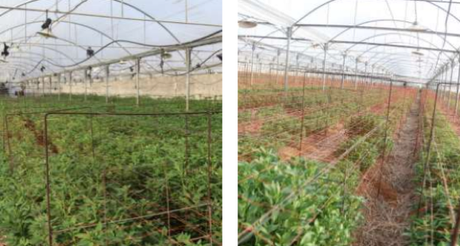Another successful Roots pilot — first in US$55B floriculture market
Published 18-DEC-2018 09:54 A.M.
|
4 minute read
Hey! Looks like you have stumbled on the section of our website where we have archived articles from our old business model.
In 2019 the original founding team returned to run Next Investors, we changed our business model to only write about stocks we carefully research and are invested in for the long term.
The below articles were written under our previous business model. We have kept these articles online here for your reference.
Our new mission is to build a high performing ASX micro cap investment portfolio and share our research, analysis and investment strategy with our readers.
Click Here to View Latest Articles
Ag-tech small cap, Roots Sustainable Agricultural Technologies (ASX:ROO), has conducted its first successful Root Zone Temperature Optimisation (RZTO) cooling pilot in the floriculture production sector — a market that’s worth US$55 billion each year.
Following on from a number of successful cooling pilots on edible herbs and promising interim results on medicinal cannabis, this latest pilot saw ROO’s patented RZTO technology used to cool the roots of Alstroemeria, a Peruvian lily.
Encouragingly, the pilot increased flower production by an additional eight weeks, despite inhospitable air temperatures.
ROO’s disruptive RZTO technology optimises plant physiology for increased growth, productivity and quality by stabilising the root zone temperature of the plant in question. It also mitigates against the impact of daily and seasonal temperature changes, helping farmers grow crops more effectively throughout the year.
These latest pilot results showed that the growth and cultivation of flowers with cooled roots started seven weeks earlier than un-cooled control plants. The extended growing season also allowed the pilot farmer, Yarden Mualem, to obtain a premium price of more than double the standard rate for out-of-season flowers.
"Due to high greenhouse temperatures during the warmer months, I previously had to limit flower harvesting to only 25 weeks a year,” Mualem explained.
"However, this early blooming accounted for a 20% increase in production – the equivalent of 150,000 flowers per hectare."
In Israel, the ability to harvest flowers year-round will double Mualem’s yield and deliver a return on investment in a year.
The pilot was conducted on the cool climate crop during the scorching Israeli summer between September and October in a quarter of an acre greenhouse. The site in central Israel holds an average of 33,000 rhizomes per hectare with each producing about 40 flowers per year.
Roots used its RZTO cooling system to keep the flower roots relatively stable at an optimal range, despite high ambient air temperatures in the greenhouse.
At 45 days growth, the RZTO-cooled Peruvian lilies (shown on the left in the image below) were full of buds and already flowering, compared to the non-cooled plants in the pilot control group, which were still in a vegetative state (on the right):

Roots CEO, Dr Sharon Devir, pointed out that the floriculture sector is very diverse and includes the production of floral crops such as cut flowers and cut foliage, flower bulbs, potted flowering, as well as foliage plants and bedding plants.
Driven by increased use in social political, sport and entertainment events, annual global floral production of these high-value crops is estimated at US$55 billion, growing at a compound annual growth rate of 5%.

“We see many opportunities with floriculture crops as crop yield optimisation and growing cycle management is critical, as most cut flowers do no travel well and have limited lifespans,” Devir said.
“Drawing on the success of RZTO on various crops, edible herbs and medicinal cannabis, we wanted to demonstrate to the floriculture sector how the Roots RZTO technology optimises the root zone temperatures – in this instance, by cooling Alstroemeria until the optimum temperature of the flower is reached and maintained.
“The RZTO system successfully cooled the root systems of the Alstroemeria seedlings, provided increased protection from the Israeli heatwave it experienced, and stabilised the temperature range between night and day.
“This allowed the farmer to dramatically increase growth and gain higher yield quantities. This would allow the possibility of additional productive growth periods, leading the farmer to benefit from higher, premium prices for longer periods for a crop that would normally be out of season,” Devir noted.
Devir added that this successful pilot has enabled Roots to undertake in-depth discussions with stakeholders in the floriculture sector, who are keen to see whether RZTO could benefit representative crops common in the industry grown under extreme conditions.
Just last week, ROO revealed outstanding interim results for its world-first open field RZTO heating pilot, showing an increase in the size of cannabis crops of up to 272%.
That pilot, which was conducted in Washington State in the US, showed that ROO’s technology could effectively stabilise the crop’s root temperatures despite air temperatures dropping below zero degrees centigrade.
Importantly, ROO is the only company in the world with commercially viable two-in-one root zone cooling and heating technology — a considerable competitive advantage in the increasingly crowded ag-tech space.
General Information Only
This material has been prepared by StocksDigital. StocksDigital is an authorised representative (CAR 000433913) of 62 Consulting Pty Limited (ABN 88 664 809 303) (AFSL 548573).
This material is general advice only and is not an offer for the purchase or sale of any financial product or service. The material is not intended to provide you with personal financial or tax advice and does not take into account your personal objectives, financial situation or needs. Although we believe that the material is correct, no warranty of accuracy, reliability or completeness is given, except for liability under statute which cannot be excluded. Please note that past performance may not be indicative of future performance and that no guarantee of performance, the return of capital or a particular rate of return is given by 62C, StocksDigital, any of their related body corporates or any other person. To the maximum extent possible, 62C, StocksDigital, their related body corporates or any other person do not accept any liability for any statement in this material.
Conflicts of Interest Notice
S3 and its associated entities may hold investments in companies featured in its articles, including through being paid in the securities of the companies we provide commentary on. We disclose the securities held in relation to a particular company that we provide commentary on. Refer to our Disclosure Policy for information on our self-imposed trading blackouts, hold conditions and de-risking (sell conditions) which seek to mitigate against any potential conflicts of interest.
Publication Notice and Disclaimer
The information contained in this article is current as at the publication date. At the time of publishing, the information contained in this article is based on sources which are available in the public domain that we consider to be reliable, and our own analysis of those sources. The views of the author may not reflect the views of the AFSL holder. Any decision by you to purchase securities in the companies featured in this article should be done so after you have sought your own independent professional advice regarding this information and made your own inquiries as to the validity of any information in this article.
Any forward-looking statements contained in this article are not guarantees or predictions of future performance, and involve known and unknown risks, uncertainties and other factors, many of which are beyond our control, and which may cause actual results or performance of companies featured to differ materially from those expressed in the statements contained in this article. S3 cannot and does not give any assurance that the results or performance expressed or implied by any forward-looking statements contained in this article will actually occur and readers are cautioned not to put undue reliance on forward-looking statements.
This article may include references to our past investing performance. Past performance is not a reliable indicator of our future investing performance.

